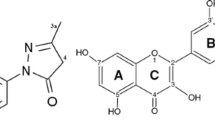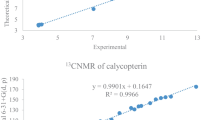Abstract
Flavonoids have long been recognized for their general health-promoting properties, of which their antioxidant activity may play an important role. In this work we have studied the properties of two flavonols, quercetin and myricetin, using semi-empirical methods in order to validate the application of the recent Parametric Model 6 and to understand the fundamental difference between the two molecules. Their geometries have been optimized and important molecular properties have been calculated. The energetic of the possible antioxidant mechanisms have also been analyzed. The two studied flavonols do not differ significantly in their molecular properties, but the antioxidant mechanisms by which they may act in solution can be rather different. Moreover, we also show that the Parametric Model 6 can produce reliable information for this type of compounds.




Similar content being viewed by others
References
Manach C, Scalbert A, Morand C, Rémésy C, Jiménez L (2004) Polyphenols: food sources and bioavailability. Am J Clin Nutr 79:727–747
Birt DF, Hendrich S, Wang W (2001) Dietary agents in cancer prevention: flavonoids and isoflavonoids. Pharmacol Ther 90:157–177. doi:10.1016/S0163-7258(01)00137-1
Bors W, Michel C (2002) Chemistry of the antioxidant effect of polyphenols. Ann N Y Acad Sci 957:57–69. doi:10.1111/j.1749-6632.2002.tb02905.x
Halliwell B, Rafter J, Jenner A (2005) Health promotion by flavonoids, tocopherols, tocotrienols, and other phenols: direct or indirect effects? Antioxidant or not? Am J Clin Nutr 81(1 Suppl):268S–276S
Williamson G, Manach C (2005) Bioavailability and bioefficacy of polyphenols in humans. II. Review of 93 intervention studies. Am J Clin Nutr 81(1 Suppl):243S–255S
Gomes A, Fernandes E, Lima JL, Mira L, Corvo ML (2008) Molecular mechanisms of anti-inflammatory activity mediated by flavonoids. Curr Med Chem 15:1586–1605
Friedman M (2007) Overview of antibacterial, antitoxin, antiviral, and antifungal activities of tea flavonoids and teas. Mol Nutr Food Res 51:116–134. doi:10.1002/mnfr.200600173
Biesalski HK (2007) 9: Polyphenols and inflammation: basic interactions. Curr Opin Clin Nutr Metab Care 10:724–728
Wang Y, Yang L, He YQ, Wang CH, Welbeck EW, Bligh SWA, Wang ZT (2008) Characterization of fifty-one flavonoids in a Chinese herbal prescription Longdan Xiegan Decoction by high-performance liquid chromatography coupled to electrospray ionization tandem mass spectrometry and photodiode array detection. Rapid Commun Mass Spectrom 22:1767–1778. doi:10.1002/rcm.3536
Heinrich M (2003) Ethnobotany and natural products: the search for new molecules, new treatments of old diseases or a better understanding of indigenous cultures? Curr Top Med Chem 3:29–42
Arts IC (2008) A review of the epidemiological evidence on tea, flavonoids, and lung cancer. J Nutr 138:1561S–1566S
Tomar RS, Shiao R (2008) Early life and adult exposure to isoflavones and breast cancer risk. J Environ Sci Health C Environ Carcinog Ecotoxicol Rev 26:113–173. doi:10.1080/10590500802074256
Linseisen J, Rohrmann S (2008) Biomarkers of dietary intake of flavonoids and phenolic acids for studying diet-cancer relationship in humans. Eur J Nutr 47:60–68. doi:10.1007/s00394-008-2007-x
de Kok TM, van Breda SG, Manson MM (2008) Mechanisms of combined action of different chemopreventive dietary compounds: a review. Eur J Nutr 47(Suppl 2):51–59. doi:10.1007/s00394-008-2006-y
Manach C, Williamson G, Morand C, Scalbert A, Rémésy C (2005) Bioavailability and bioefficacy of polyphenols in humans. I. Review of 97 bioavailability studies. Am J Clin Nutr 81(1 Suppl):230S–242S
Boots AW, Haenen GR, Bast A (2008) Health effects of quercetin: from antioxidant to nutraceutical. Eur J Pharmacol 585:325–327. doi:10.1016/j.ejphar.2008.03.008
Oyama Y, Fuchs PA, Katayama N, Noda K (1994) Myricetin and quercetin, the flavonoid constituents of Ginkgo biloba extract, greatly reduce oxidative metabolism in both resting and Ca(2+)-loaded brain neurons. Brain Res 635:125–129. doi:10.1016/0006-8993(94)91431-1
Gordon MH, Roedig-Penmanm A (1998) Antioxidant activity of quercetin and myricetin in liposomes. Chem Phys Lipids 97:79–85. doi:10.1016/S0009-3084(98)00098-X
Furuno K, Akasako T, Sugihara N (2002) The contribution of the pyrogallol moiety to the superoxide radical scavenging activity of flavonoids. Biol Pharm Bull 25:19–23. doi:10.1248/bpb.25.19
Zhang H-Y, Sun Y-M, Wang X-L (2003) Substituent effects on O-H bond dissociation enthalpies and ionization potentials of catechols: A DFT study and its implications in the rational design of phenolic antioxidants and elucidation of structure-activity relationships for flavonoid antioxidants. Chem Eur J 9:502–508. doi:10.1002/chem.200390052
Litwinienko G, Ingold KU (2007) Solvent effects on the rates and mechanisms of reaction of phenols with free radicals. Acc Chem Res 40:222–230. doi:10.1021/ar0682029
Mayo SL, Olafson BD, Goddard WA III (1990) DREIDING: a generic force field for molecular simulations. J Phys Chem 94:8897–8909. doi:10.1021/j100389a010
Marvin version 5.00 and Calculator Plugins for Marvin 500 2008 ChemAxon (http://wwwchemaxoncom)
MOPAC2009 James J P Stewart Stewart Computational Chemistry Version 9034 L. http://OpenMOPACnet
Baker J (1986) An algorithm for the location of transition states. J Comp Chem 7:385–395. doi:10.1002/jcc.540070402
Dewar MJS, Thiel W (1977) Ground states of molecules. 38. The MNDO method. Approximations and parameters. J Am Chem Soc 99:4899–4907. doi:10.1021/ja00457a004
Dewar MJS, Zoebisch EG, Healy EF, Stewart JJP (1985) Development and use of quantum mechanical molecular models. 76. AM1: a new general purpose quantum mechanical molecular model. J Am Chem Soc 107:3902–3909. doi:10.1021/ja00299a024
Rocha GB, Freire RO, Simas AM, Stewart JJP (2006) RM1: A reparameterization of AM1 for H, C, N, O, P, S, F, Cl, Br, and I. J Comp Chem 27:1101–1111. doi:10.1002/jcc.20425
Stewart JJP (1989) Optimization of parameters for semiempirical methods I. Method J Comp Chem 10:209–220. doi:10.1002/jcc.540100208
Stewart JJP (2007) Optimization of parameters for semiempirical methods V: modification of NDDO approximations and application to 70 elements. J Mol Modeling 13:1173–1213. doi:10.1007/s00894-007-0233-4
Klamt A, Schüürmann G (1993) COSMO: a new approach to dielectric screening in solvents with explicit expressions for the screening energy and its gradient. J Chem Soc Perkin Trans 2:799–805. doi:10.1039/P29930000799
Antonczak S (2008) Electronic description of four flavonoids revisited by DFT method. THEOCHEM 856:38–45. doi:10.1016/j.theochem.2008.01.014
Fiorucci S, Golebiowski J, Cabrol-Bass D, Antonczak S (2007) DFT study of quercetin activated forms involved in antiradical, antioxidant, and prooxidant biological processes. J Agric Food Chem 55:903–911. doi:10.1021/jf061864s
Klein E, Lukeš V, Ilčin M (2007) DFT/B3LYP study of tocopherols and chromans antioxidant action energetics. Chem Phys 336:51–57. doi:10.1016/j.chemphys.2007.05.007
Lide DA (2004) CRC handbook chemistry and physics. CRC Press Inc, Boca Raton, FL, USA
Parr RG, Szentpály L, Liu S (1999) Electrophilicity index. J Am Chem Soc 121:1922–1924. doi:10.1021/ja983494x
Mendoza-Wilson AM, Glossman-Mitnik D (2005) CHIH-DFT study of the electronic properties and chemical reactivity of quercetin. THEOCHEM 716:67–72. doi:10.1016/j.theochem.2004.10.083
Vasilescu D, Girma R (2002) Quantum molecular modeling of quercetin - simulation of the interaction with the free radical t-BuOO. Int J Quantum Chem 90:888–902. doi:10.1002/qua.1801
Russo N, Toscano M, Occella N (2000) Semiempirical molecular modeling into quercetin reactive site: structural, conformational, and electronic features. J Agric Food Chem 48:3232–3237. doi:10.1021/jf990469h
Leopoldini M, Marino T, Russo N, Toscano M (2004) Antioxidant Properties of Phenolic Compounds: H-Atom versus Electron Transfer Mechanism. J Phys Chem A 108:4916–4922. doi:10.1021/jp037247d
Leopoldini M, Russo N, Toscano M (2006) Gas and liquid phase acidity of natural antioxidants. J Agric Food Chem 54:3078–3085. doi:10.1021/jf053180a
Leopoldini M, Marino T, Russo N, Toscano M (2004) Density functional computations of the energetic and spectroscopic parameters of quercetin and its radicals in the gas phase and in solvent. Theor Chem Acc 111:210–216. doi:10.1007/s00214-003-0544-1
Carpenter JE, Weinhold F (1988) Analysis of the geometry of the hydroxymethyl radical by the “different hybrids for different spins” natural bond orbital procedure. THEOCHEM 169:41–62. doi:10.1016/0166-1280(88)80248-3
Carpenter JE, Reed WF, AE WF (1985) Natural localized molecular orbitals. J Chem Phys 83:1736–1740. doi:10.1063/1.449360
Cornard JP, Merlin JC, Boudet AC, Vrielynck L (1997) Structural study of quercetin by vibrational and electronic spectroscopies combined with semiempirical calculations. Biospectroscopy 3:183–193. doi:10.1002/(SICI)1520-6343(1997)3:3<183::AID-BSPY2>3.0.CO;2-7
van Acker SABE, de Groot MJ, van den Berg M-J, Tromp MNJL, den Kelder GD-O, Vijgh WJF, Bast A (1996) A quantum chemical explanation of the antioxidant activity of flavonoids. Chem Res Toxicol 9:1305–1312. doi:10.1021/tx9600964
Yates PC (1991) Semi-empirical molecular orbital calculations on tyrosine kinase inhibitors and structurally related compounds. THEOCHEM 231:201–213. doi:10.1016/0166-1280(91)85218-V
Erlejman AG, Verstraeten SV, Fraga CG, Oteiza PI (2004) The interaction of flavonoids with membranes: potential determinant of flavonoid antioxidant effects. Free Radic Res 38:1311–1320. doi:10.1080/10715760400016105
Olivero-Verbel J, Pacheco-Londoño L (2002) Structure − Activity Relationships for The Anti-HIV Activity of Flavonoids. J Chem Inf Comput Sci 42:1241–1246. doi:10.1021/ci020363d
Bonin KD, Kresin VV (1997) Electric-Dipole Polarizabilities of Atoms Molecules and Clusters. World Scientific, Singapore
Foresman JB, Frisch AE (1996) Exploring Chemistry with Electronic Structure Methods. Gaussian, Pittsburgh PA, USA
Lewars E (2003) Computational Chemistry—Introduction to the Theory and Applications of Molecular and Quantum Mechanics. Kluwer Academic Publishers, Norwell MA, USA
Hatch FT, Lightstone FC, Colvein ME (2000) Quantitative structure-activity relationship of flavonoids for inhibition of heterocyclic amine mutagenicity. Environ Mol Mutagen 35:279–299. doi:10.1002/1098-2280(2000)35:4<279::AID-EM3>3.0.CO;2-9
Rasulev BF, Abdullaev ND, Syrov VN, Leszczynski J (2005) A quantitative structure-activity relationship (QSAR) study of the antioxidant activity of flavonoids. QSAR Combin. Sci 24:1056–1065. doi:10.1002/qsar.200430013
Chaudière J, Ferrari-Iliou R (1999) Intracellular antioxidants: from chemical to biochemical mechanisms. Food Chem Toxicol 37:949–962. doi:10.1016/S0278-6915(99)00090-3
Martins HFP, Fernandez MT, Lopes VHC, Cordeiro MNDS (2004) Toward the prediction of the activity of antioxidants: experimental and theoretical study of the gas-phase acidities of flavonoids. J Am Soc Mass Spectrom 15:848–861. doi:10.1016/j.jasms.2004.02.007
Li MJ, Liu L, Fu Y, Guo QX (2007) Accurate bond dissociation enthalpies of popular antioxidants predicted by the ONIOM-G3B3 method. THEOCHEM 815:1–9. doi:10.1016/j.theochem.2007.03.012
Trouillas P, Marsal P, Siri D, Lazzaroni R, Duroux JL (2006) A DFT study of the reactivity of OH groups in quercetin and taxifolin antioxidants: the specificity of the 3-OH site. Food Chem 97:679–688. doi:10.1016/j.foodchem.2005.05.042
Wolfe KL, Liu RH (2008) Structure − activity relationships of flavonoids in the cellular antioxidant activity assay. J Agric Food Chem 56:8404–8411. doi:10.1021/jf8013074
Munoz-Munoz JL, Garcia-Molina F, Molina-Alarcón M, Tudela J, Carcía-Cánovas F, Rodríguez-López JN (2008) Kinetic characterization of the enzymatic and chemical oxidation of the catechins in green tea. J Agric Food Chem 56:9215–9224. doi:10.1021/jf8012162
Tsimogiannis DI, Oreopoulou V (2005) The contribution of flavonoid C-ring on the DPPH free radical scavenging efficiency. A kinetic approach for the 3′,4′-hydroxy substituted members. Innov Food Sci Emerg Technol 7:140–146. doi:10.1016/j.ifset.2005.09.001
Wang LF, Zhang HY (2004) Unexpected role of 5-OH in DPPH radical-scavenging activity of 4-thiaflavans. Revealed by theoretical calculations. Bioorg Med Chem Lett 14:2609–2611. doi:10.1016/j.bmcl.2004.02.066
Acknowledgments
G. C. J. would like to acknowledge a post-doctoral grant from Fundação para a Ciência e a Tecnologia (SFRH/BPD/2006/27563). The authors would also like to thank Dr. Marta Corvo and one of the reviewers for very significant discussions.
Author information
Authors and Affiliations
Corresponding author
Electronic supplementary materials
Below is the link to the electronic supplementary material.
Esm 1
(DOC 216 kb)
Rights and permissions
About this article
Cite this article
Justino, G.C., Vieira, A.J.S.C. Antioxidant mechanisms of Quercetin and Myricetin in the gas phase and in solution – a comparison and validation of semi-empirical methods. J Mol Model 16, 863–876 (2010). https://doi.org/10.1007/s00894-009-0583-1
Received:
Accepted:
Published:
Issue Date:
DOI: https://doi.org/10.1007/s00894-009-0583-1




